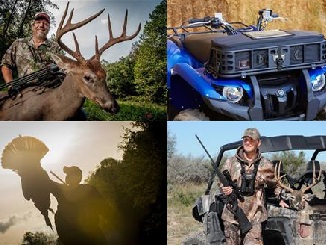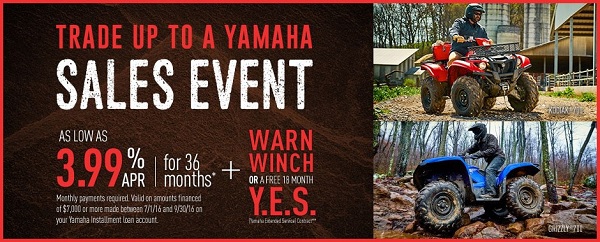Yamaha Outdoors Tips – “Tasteful Hunting Photos” and “ATV Tool Kit” for all hunters to learn about. What is the best way to take game photos and what do you need in your basic tool kit for your ATV?
Part One, By Stephanie Mallory Yamaha Writer – Taste Hunting Photos
You’ve enjoyed a successful hunt, and you can’t wait to share photos of your trophy animal on social media. Before you start clicking away with your camera or smartphone, take a few steps to ensure your photos are clear, classy and respectful of the fine animal you want to show off.
Renowned outdoor photographer Bill Konway has some tips for ensuring your photos showcase your trophy animal in a tasteful and appealing manner.
“Whether you’ve taken a big-game animal, waterfowl or small-game animal, if you’re shooting a photo of it, it’s worth shooting it well,” Konway said. “If you’ll take a few minutes to prepare your animal and select the right location, you’ll have a photo that can be the envy of all your hunting buds.”
Konway provides the following tips for enviable trophy game photos:
1. Wipe excess blood from the face, nose, mouth and body of your trophy. Unscented baby wipes or even a bottle of water can help in removing blood from the hide or feathers.
2. In the case of big game, push the animal’s tongue back into its mouth, or remove it entirely with a sharp knife.
3. Those who want to go the extra mile can place glass taxidermy eyes over the deer’s eyes. Glass eyes are a worthwhile $20 investment if you shoot these types of photos regularly.
4. Position the animal so that it is entirely unobstructed by busy horizons, power lines, trees and other objects. Sometimes lying on the ground and shooting upward provides the best angle, at other times, shooting down from above the hunter and trophy works best.
5. By all means be sure to place your bow, gun, ATV, Side-by-Side or other favorite hunting items in your frame. But, make sure the gear or vehicle does not block or shade the key features of the animal you want to show off.
6. When photographing antlered animals, make sure each and every point can be seen. Turn the head both directions and tip the nose up or down to determine the best view. Although the pose might look unusual from one angle, it may be perfect from the camera’s angle. In the case of a turkey, always try to make the beard, as well as the spurs, visible if possible.
7. Make the most of the light you have. Overcast lighting makes for the best photos, but obviously it’s not always available. Waiting for morning light after an evening kill will typically result in better photos than trying to shoot in the dark with a flash stuck on the camera. If you’re forced to shoot in the dark or with a flash, be sure to instruct the hunter to raise his or her hat brim a bit to eliminate the shadow across his or her face. You can also turn the camera upside down so the camera’s flash comes from beneath the hat, giving better shadowless light on the hunter’s face.
8. Study the hero photos you see in hunting magazines for ideas of which poses work and which don’t. Look at the screen on the back of your camera. If it doesn’t look too good there, it’s probably not going to look too good as a print or as a post on social media.
9. As they say, practice makes perfect. Shoot a bunch of photos and try several angles. You’ll eventually learn what works and what doesn’t.
10. If you’ll follow these tips, you’ll end up with classy, head-turning photos that you can proudly show off wherever and whenever you want.
Part Two, By Bob Humphrey Yamaha Writer – ATV Tool Kit
Proper upkeep and maintenance can help you avoid many of the possible reasons for a break down, but you still may encounter circumstances beyond your control. Furthermore, other riders in your group may not be as conscientious, or you may encounter someone else broken down along the trail. In any case, it’s always a good idea to carry a tool kit when riding.
STOCK ITEMS
Your rig came with a basic tool kit consisting of wrenches, pliers and screwdrivers that will fit most of the fasteners and fixtures. You should always carry it with you, and check periodically to make sure all the tools are in it. Occasional use could result in tools being misplaced or missing.
EXTRAS
Multi-Tool – Without question, a multi-tool is one of the most useful tools you can carry. The various blades and implements can be used for an array of trail repair jobs.
Lube – A small squirt can of WD-40 or other lubricant can help silence squeaks or loosen tough nuts.
Pressure Gauge – You’ll want to check pressure periodically, especially on long rides. You may also want to adjust pressure on varying terrain, letting air out on loose sand, then refilling at the next service station.
Quick Fixes – A few cable ties and a roll of duct tape can sometimes come in handy for a quick fix on hoses or loose parts that will at least get you back to the trail head or the closest service station.
Navigation – A compass should be considered mandatory. A GPS and/or smart phone with GPS and mapping capability are also quite handy, particularly if you break down and need to determine the shortest direction to reach assistance. You may also want to carry a charger to ensure neither of the latter two run out of power.
Wipes – Rags, paper towels or toilet tissue will suffice, but wet wipes are a better option for cleaning areas for closer inspection and repair, and cleaning up after a repair job. Carry a few in a ziploc bag, which also might come in handy for other uses.
Survival Kit – Like insurance, you hope you never need it, but it’s nice to know it’s there if you do. And with the minimal space required, you’d be foolhardy not to carry a basic survival kit containing the following basic items: flashlight, signal whistle, fire-starter, lighter or waterproof matches and a knife. You may also want to add things like a space blanket, parachute cord, protein bars and miscellaneous first aid items.

